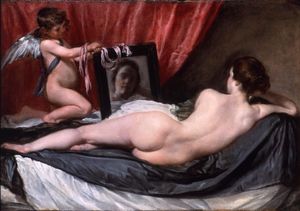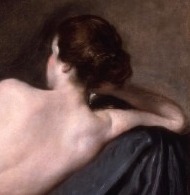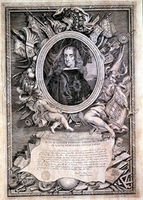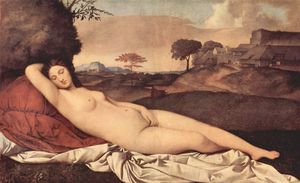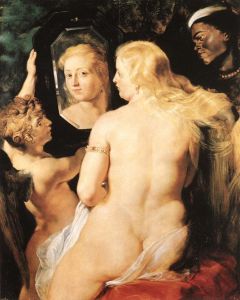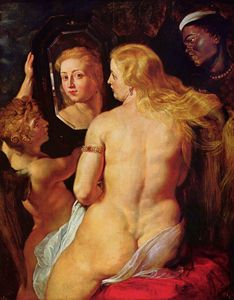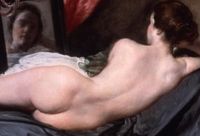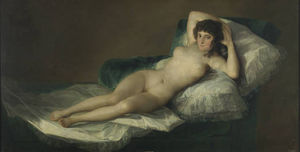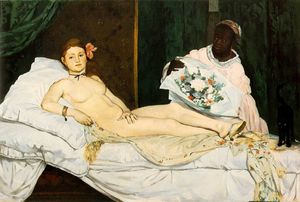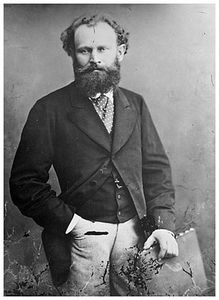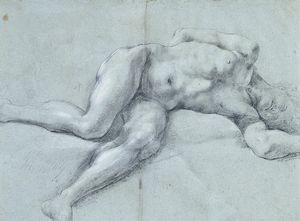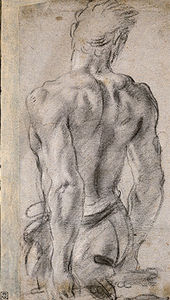The Toilet of Venus
- Date of Creation:
- circa 1651
- Alternative Names:
- The Rokeby Venus, Venus at her toilet
- Height (cm):
- 122.50
- Length (cm):
- 177.00
- Medium:
- Oil
- Support:
- Canvas
- Subject:
- Scenery
- Art Movement:
- Baroque
- Created by:
- Current Location:
- London, United Kingdom
- Displayed at:
- National Gallery London
- Owner:
- National Gallery London
The Toilet of Venus Story / Theme
One of Velázquez's most famous and admired paintings, The Toilet of Venus (also known as The Rokeby Venus, Venus at her toilet, or Venus del espejo) depicts the Goddess of Love admiring herself in her bedchamber with the help of her son Cupid, who props up a mirror for her divine contemplation.
Although this particular scene does not have its roots in a particular source (literary or otherwise), the subject was common in Italian painting and antiquity. Venus seen from behind was a common erotic figure in antiquity.
The circumstances surrounding the commission of The Toilet of Venus are shrouded in mystery. This is the only surviving nude by Velázquez and nudity in painting was conceived of as a mortal sin punishable by law during the Spanish Baroque, unlike in France, Italy, or Flanders, where nude and provocatively posed ladies abounded.
The patron of this work would thus have been loathe to leave any records proving his commission or purchase of such a piece. Based on stylistic criteria, however, art historians have tentatively dated the picture to the time of Velázquez's second trip to Italy.
Today it has been established that by the 1st of June, 1651, the painting was in the collection of Gaspar Méndez de Haro y Guzman, who was the Marqués del Carpo and grand-nephew of the Count Duke Olivares, Velázquez's first important patron.
Guzman was a notorious womanizer and lover of pictures, and The Toilet of Venus hung next to a similarly risqué Italian picture of a nude nymph in a landscape. Given this evidence, it has long been assumed that Guzman commissioned the picture, but recent research has revealed that in fact Guzman purchased the picture from a third party. For whom, then, was the picture actually painted? The world of art may never know.
The Toilet of Venus Inspirations for the Work
Although female nudes were of the utmost scarcity in Spanish art, Velázquez would have encountered many examples of this same subject both in Philip IV's collection of Italian paintings, and during both of his trips to Italy. The following artists and paintings could very well have provided both stylistic and compositional inspiration for the Spanish artist;
Giorgione, Sleeping Venus, c. 1510:
This archetype of the female nude was executed by Venetian painter Giorgione, a star of the Italian Renaissance. While a painting with such overtly sensuous implications would hardly have been acceptable in Baroque Spain, a painting such as this would surely have been an important source of inspiration for Velázquez's own rendering of a reclining female nude.
Titian, Venus with a Mirror. c. 1555:
Titian was the supreme influence on Velázquez, who undoubtedly admired the Italian artist's numerous depictions of the female nude.
Titian's rendering of this theme is more traditional than that of the Spaniard: this voluptuous Venus is shown as a blonde, in keeping with traditional depictions of the goddess, with her traditional mythological accoutrements (jewels, etc. ), and wrapped in sensual furs.
Rubens, Venus at the Mirror. c. 1615:
Rubens' rendition of this popular theme is perhaps the closest to Velázquez's The Toilet of Venus. Like in the Velázquez, this buxom blonde goddess is shown from the back and she ogles the viewer from her vanity mirror as the onlooker takes in her sumptuous curves.
Rubens's painting is filled with the sweeping energy and dynamism that defines Baroque art, which has a kindred spirit in Velázquez's sweeping curves and counter-curves.
The Borghese Hermaphrodite:
Velázquez ordered a bronze cast of this surprising masterpiece of Hellenistic art during his second trip to Italy. The pose and figure of this reclining nude was undeniably a source of inspiration for Velázquez's Venus.
The Toilet of Venus Analysis
In keeping with the innovation that marks the rest of his oeuvre, Velázquez's painting is a major departure from all precedent interpretations of Venus at her toilet.
Composition:
The Toilet of Venus is based on the form of the curve: the smooth, Venus's gentle curves are echoed in the swooping draperies, the billowing ribbon and the protruding belly of the Cupid.
As one art historian has pointed out, Velázquez's slender, lithe figure, with her jutting hip and shoulder bones, is worlds apart from the sumptuous, voluptuous specimens of the Italian and Flemish paintings. Velázquez's Venus is not an idealized goddess of sensual delights, but instead a rather ordinary, all-too-human girl from Spain. She even has brown hair, a major departure from the traditional blonde Venus.
Furthermore, this Venus is depicted with the utmost simplicity, with none of the jewels, exotic furs, or sensual oils that usually accompany the goddess. In fact, The Toilet of Venus could very easily be a portrait of any anonymous Spanish woman, were it not for the presence of the winged Cupid, the only element that lifts this painting out of the human realm.
The ribbon:
The signification of the ribbon is one of the most often discussed elements of the painting. What is its purpose? Is it mere decoration? Was it used to hang the mirror upon the wall? To blindfold the Venus? Or, as art critic Julián Gallego suggests, could it be that the ribbon binds poor Cupid to Venus and the image of beauty? Art historians have yet to definitively answer the question, and the ribbon rests yet another enigma in Velázquez's often puzzling oeuvre.
The mirror:
Just like in Las Meninas, the mirror is a somewhat enigmatic focal point in The Toilet of Venus. Like in Rubens's Venus at her Mirror, The Toilet of Venus is actually gazing at the viewer as she offers him (or her) a rather intimate view of her anatomy. Her reflection in the mirror, however, is strangely blurred and fuzzy-but why?
Art critic Natasha Wallace suggests that this blurred reflection could reveal the very meaning of the painting. According to Wallace, the mirrored reflection is "an image of self-absorbed beauty. " For Wallace, therefore, The Toilet of Venus is thus a picture purely about appreciating beauty and "aesthetic sexuality. "
While this could indeed be one layer of signification, the mirror is a symbol overcharged with meaning, which refers to fundamental questions about the relationship between art and reality.
Color palette:
Velázquez's painting is based on a simple palette scheme dominated by red, blue and white. All of these colors are reflected in the skin of the Cupid and Venus, carefully blended with smooth, creamy, free brushstrokes.
The Toilet of Venus Critical Reception
A mysterious model
Who is The Toilet of Venus? Some have suggested that the model for the Venus also appears in Las Hilanderas. Others have even proposed that the model could be Velázquez's Italian mistress, with whom he had a child during his second trip to Italy.
Due to the fact that The Toilet of Venus was kept under wraps until 1857, its influence on the art world was somewhat delayed. It was not until 1857 that artists could fully appreciate Velázquez's deviance from classical depictions of intimacy and sleep, typically seen in works from antiquity and Venetian art portraying Venus.
Velázquez's simple image of the female nude-without jewelery or accessories-inspired many later nude studies by Manet and Ingres among others. Furthermore, Velázquez's choice of depicting Venus from the rear was novel and has since been copied by later artists. A notable example is Manet's Olympia (See Related Paintings) which initially shocked the Parisian art world upon its exhibition in 1863.
The Toilet of Venus Related Paintings
The Toilet of Venus Locations Through Time - Notable Sales
The first recording of The Toilet of Venus was in June 1651 when it was part of the collection of the Marqués del Carpio, son of the First Minister of Spain. Due to the controversial nature of the subject, Velázquez's The Toilet of Venus was kept more or less hidden in private rooms while it remained in Spain. John Morritt, an English lord, acquired the painting in 1813 for a mere 500 pounds and brought it to England (interestingly, he bought it under the advice of his notorious literary friend, Sir Thomas Lawrence). Morritt kept the painting at Rokeby Park in Yorkshire (then known as Rokeby Hall).
Even after it was bought by and taken to the United Kingdom, the picture was kept in private apartments and hung in such a way as to avoid offending delicate sensibilities. The painting thus was not available to the public until 1857, when it was shown in at the Manchester Art Treasures exhibit.
The Toilet of Venus went on permanent public display in 1906, when it was acquired by the National Gallery in London. Although this work was attacked and badly damaged in 1914 by the suffragette Mary Richardson, it was fully restored and remained on display. Huge public support called for the acquisition of the painting, and King Edward VII even contributed financially, to prevent it from being removed from the country by "wealthy Americans" who were interested in purchasing the work.
The Toilet of Venus Artist
The Toilet of Venus is a rare example of a female nude in Spanish art; three other nudes have been recorded by Velázquez, but they are now lost. Paintings of nudity were seen as immoral, and the Inquisition would commonly seize and destroy or repaint such subjects, while the artists who executed them could be excommunicated and banished from Spain.
In fact, the poet and priest Fray Hortensio Félix suggested that "the finest paintings are the greatest threat: burn the best of them. " Nonetheless, important nobles and even the King himself managed to get around these rules by keeping their naughty pictures in hidden rooms, away from the public eye.
Velázquez's mythological paintings such as The Toilet of Venus are some of the most exquisite in the history of art and are characterized by;
Careful realism; even mythological figures are portrayed as real people
Typically, a lighter, brighter palette than the bodegones, portraits or religious works
Velázquez has not ceased to be a remarkably fecund source of inspiration for art critics and art historians up until the present day, nor has his reputation as one of the greatest painters of all time been dimmed.
Velázquez paved the way for early nineteenth century realist and impressionist painters, especially Édouard Manet. Since then, he has gone on to influence artists as diverse as Pablo Picasso, Salvador Dalí, and Anglo-Irish painter Francis Bacon. Such artists have demonstrated their love for the works of Velázquez by recreating some of his most noted paintings.
Diego Velázquez was hailed a father of the Spanish school of art and is one of the greatest artists that ever lived.
The Toilet of Venus Art Period
Diego Rodriguez de Silva y Velázquez was born into a society of paradox: Spain was simultaneously undergoing one of the most dramatic economic and political declines of any nation in European history, and unprecedentedly fertile, creative bursts of artistic activity.
In Velázquez's hometown of Seville in particular, circles of Humanist learning, arts and letters and philosophy all flourished, constituting a particularly fecund environment for a young artist.
On the other hand, Velázquez's chosen profession would become a significant obstacle in the artist's personal agenda. Spanish society was obsessed with nobility, and unlike in Italy, the visual arts were emphatically not equated with noble pursuits like literature or philosophy.
Artists were seen as essentially vulgar craftsman who worked for a living with their hands, just like blacksmiths or tailors. Making matters even more complicated, the Catholic church exercised almost total power over the arts in Spain, dictating everything from subject to composition, meaning that artists had very little room to experiment or grow. Velázquez was thus fated to struggle from the very incipience of his career.
While most artists of the Baroque period suffered from a serious drop in critical opinion during the 18th century, eventually fading into oblivion until being rediscovered in the 1950s, Velázquez took an alternate route.
Because of Spain's political situation, the nation was more or less isolated from the rest of Europe during the heights of Neoclassicism, meaning that Velázquez's reputation was safe from the hands of Baroque-haters like Wincklemann, who managed to destroy the reputation of such artists as Caravaggio, Carracci and Bernini.
By the time Spain opened up to the rest of Europe in the beginning of the 19th century, the world was ready for Velázquez, and critics and artists alike haven't ceased singing the master painter's praises.
The Toilet of Venus Bibliography
The following list offers some of the best sources of further reading on Velázquez and his works.
• Brown, Dale. The World of Velázquez: 1599-1660. Time-Life Books, 1969
• Brown, Jonathan. Velázquez, Painter and Courtier. Yale University Press, 1986
• Carr, Dawson, et al. Velázquez. Yale University Press, 2006
• Davies, David, et al. Velázquez in Seville. National Galleries of Scotland, 1996
• Harris, Enriqueta. Velázquez. Phaidon, 1982
• Kahr, Madlyn Millner. Velázquez: the art of painting. Harper and Row, 1976
• López-Rey, José. Velázquez: A catalogue raisonné of his œuvre. Faber and Faber, 1963
• Pérez Sánchez, Alfonso, et al. Velázquez. The Metropolitan Museum of Art, 1989
• Wolf, Norbert. Diego Velázquez, 1599-1660: the face of Spain. Taschen, 1998
• Wind, Barry. Velázquez's Bodegones: A study in 17th century Spanish genre painting. Fairfax: George Mason University Press, 1987

